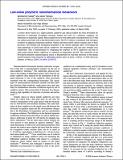Por favor, use este identificador para citar o enlazar a este item:
http://hdl.handle.net/10261/18075COMPARTIR / EXPORTAR:
 SHARE SHARE
 CORE
BASE CORE
BASE
|
|
| Visualizar otros formatos: MARC | Dublin Core | RDF | ORE | MODS | METS | DIDL | DATACITE | |

| Campo DC | Valor | Lengua/Idioma |
|---|---|---|
| dc.contributor.author | Calleja, Montserrat | - |
| dc.contributor.author | Tamayo de Miguel, Francisco Javier | - |
| dc.contributor.author | Nordström, M. | - |
| dc.contributor.author | Boisen, Anja | - |
| dc.date.accessioned | 2009-10-27T08:31:00Z | - |
| dc.date.available | 2009-10-27T08:31:00Z | - |
| dc.date.issued | 2006-05-14 | - |
| dc.identifier.citation | Applied Physic Letters 88, 113901 (2006) | en_US |
| dc.identifier.issn | 0003-6951 | - |
| dc.identifier.uri | http://hdl.handle.net/10261/18075 | - |
| dc.description.abstract | A sensor device based on a single polymer cantilever and optical readout has been developed for detection of molecular recognition reactions without the need of a reference cantilever for subtraction of unspecific signals. Microcantilevers have been fabricated in the photoresist SU-8 with one surface passivated with a thin fluorocarbon layer. The SU-8 surface is sensitized with biological receptors by applying silanization methods, whereas the fluorocarbon surface remains inert to these processes. The thermal and mechanical properties of the chosen materials allow overcoming the main limitations of gold-coated silicon cantilevers: the temperature, pH, and ionic strength cross sensitivities. This is demonstrated by comparing the response of SU-8 cantilevers and that of gold-coated silicon nitride cantilevers to variations in temperature and pH. The sensitivity of the developed polymeric nanomechanical sensor is demonstrated by real-time detection of the human growth hormone with sensitivity in differential surface stress of about 1 mN/m. | en_US |
| dc.description.sponsorship | The authors acknowledge J. M. Rodríguez-Prado and M. Mellado for providing reagents for the molecular recognition experiments and J. Treviño, E. Mauriz, and D. Haefliger for fruitful discussion. J.T. and M.C. acknowledge financial support from the Spanish Ministry of Science (MERG-CT-2004- 510638) and the European Union (GEN2001-4856-C13-11). | en_US |
| dc.format.extent | 129313 bytes | - |
| dc.format.mimetype | application/pdf | - |
| dc.publisher | American Institute of Physics | en_US |
| dc.rights | openAccess | en_US |
| dc.subject | Cantilevers | en_US |
| dc.subject | polymers | en_US |
| dc.subject | nanotechnology | en_US |
| dc.subject | microsensors | en_US |
| dc.subject | molecular biophysics | en_US |
| dc.subject | photoresists | en_US |
| dc.subject | passivation | en_US |
| dc.subject | Coatings | en_US |
| dc.subject | pH | en_US |
| dc.subject | gold | en_US |
| dc.subject | Silicon compounds | en_US |
| dc.subject | Biological techniques | en_US |
| dc.title | Low-noise polymeric nanomechanical biosensors | en_US |
| dc.type | artículo | en_US |
| dc.identifier.doi | 10.1063/1.2187437 | - |
| dc.description.peerreviewed | Peer reviewed | en_US |
| dc.relation.publisherversion | http://link.aip.org | en_US |
| dc.relation.publisherversion | http://dx.doi.org/10.1063/1.2187437 | en_US |
| dc.type.coar | http://purl.org/coar/resource_type/c_6501 | es_ES |
| item.openairetype | artículo | - |
| item.grantfulltext | open | - |
| item.cerifentitytype | Publications | - |
| item.openairecristype | http://purl.org/coar/resource_type/c_18cf | - |
| item.fulltext | With Fulltext | - |
| Aparece en las colecciones: | (IMN-CNM) Artículos | |
Ficheros en este ítem:
| Fichero | Descripción | Tamaño | Formato | |
|---|---|---|---|---|
| Calleja, M. et al Appl.Phys.Lett._88_2006.pdf | 126,28 kB | Adobe PDF |  Visualizar/Abrir |
CORE Recommender
SCOPUSTM
Citations
71
checked on 20-abr-2024
WEB OF SCIENCETM
Citations
50
checked on 27-feb-2024
Page view(s)
371
checked on 19-abr-2024
Download(s)
349
checked on 19-abr-2024
Google ScholarTM
Check
Altmetric
Altmetric
NOTA: Los ítems de Digital.CSIC están protegidos por copyright, con todos los derechos reservados, a menos que se indique lo contrario.
